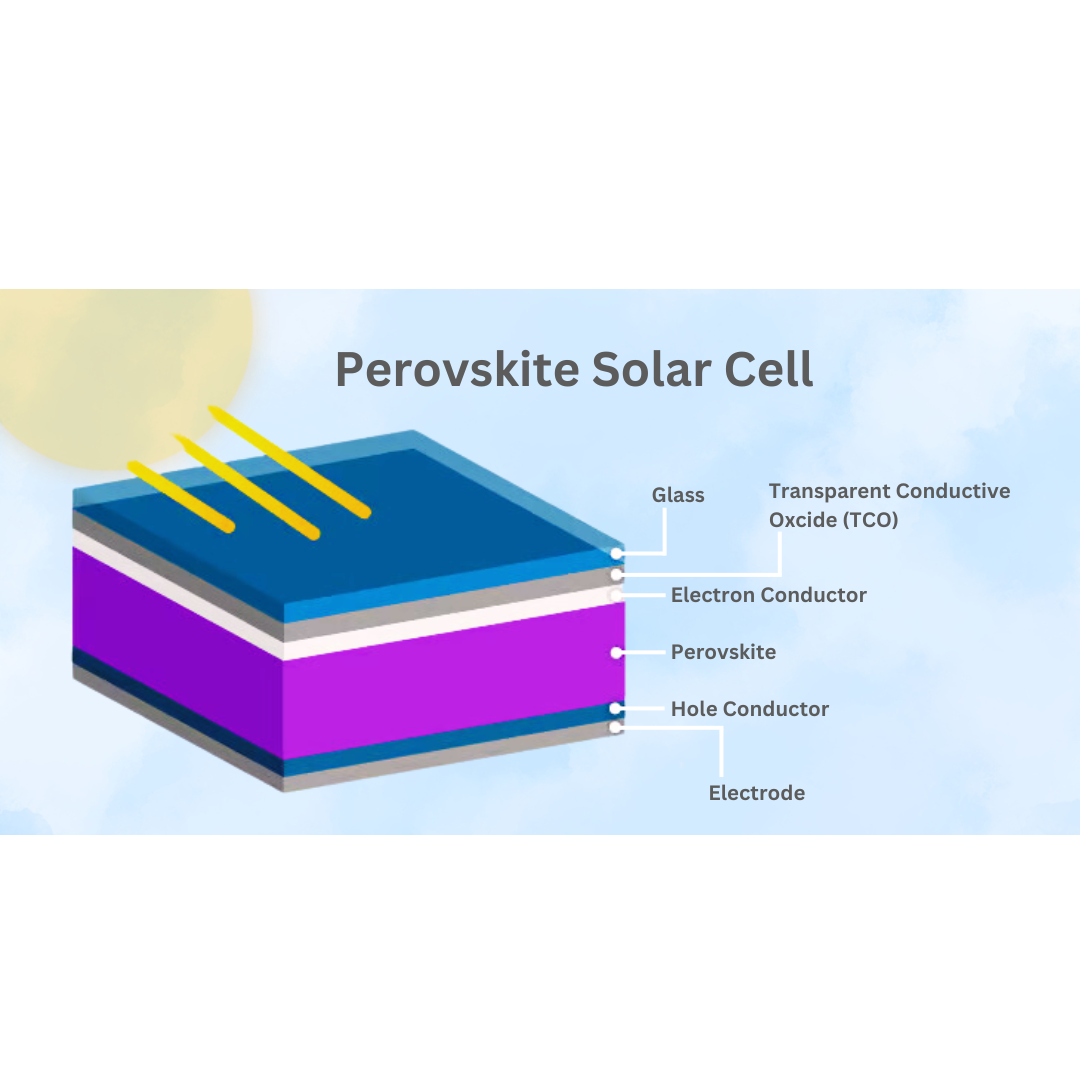In the quest for cleaner and more efficient energy sources, perovskite solar cells have emerged as a powerful innovation within the solar industry. These advanced solar cells are gaining attention for their efficiency, versatility, and potential to reshape the renewable energy landscape. In this blog, we’ll delve into the unique properties of perovskite solar cells, how they work, their benefits, challenges, and their role in the future of solar energy.
Table of Contents
What Are Perovskite Solar Cells?
Perovskite solar cells are a type of photovoltaic (PV) technology that uses perovskite-structured compounds as the light-harvesting active layer. Named after the naturally occurring mineral perovskite, these materials are known for their excellent light absorption and charge-carrier mobilities, making them well-suited for solar applications. The unique composition of perovskite materials, typically consisting of lead or tin-based compounds, allows them to absorb sunlight effectively across a broad spectrum, improving the cell’s overall efficiency.
A thin film photovoltaic device with a perovskite material as the active layer is called a perovskite solar cell. Perovskites are used in these devices to capture solar radiation and transform it into electrical energy. Some perovskites are quite good at this because of their basic characteristics. Perovskites are superior to the components found in modern solar cells in several respects.
One of the reasons perovskite solar cells have generated so much excitement in the scientific community is that they offer a multitude of intriguing applications.

How Perovskite Solar Cells Work
The working mechanism of perovskite solar cells is similar to that of traditional silicon-based solar cells. Here’s a step-by-step look at how they operate:
1. Light Absorption: Perovskite materials efficiently absorb photons from sunlight across various wavelengths, converting light energy into electrons. Sunlight hits the perovskite layer, exciting electrons and creating electron-hole pairs.
2. Electron Excitation: When photons hit the perovskite layer, they excite electrons to a higher energy level, creating electron-hole pairs (positive and negative charges).
3. Charge Separation: These charges are separated by a transport layer, which helps direct the electrons and holes to different electrodes within the solar cell.
4. Electricity Generation: The separated charges then move toward electrodes, creating an electric current as they pass through an external circuit.
The perovskite layer’s flexibility in absorbing light more efficiently than silicon results in impressive power conversion efficiencies, positioning these cells as potential game-changers in the solar market.
Key Benefits of Perovskite Solar Cells
1. High Efficiency
- Perovskite-based solar cells have shown an impressive rise in efficiency over the last decade (recent studies have even passed 30%), which hopefully will allow for high-performance, low-cost PVs. This rapid improvement is one of the primary reasons perovskite solar technology is considered a promising alternative to traditional solar cells.
2. Cost-Effectiveness
- Perovskite cells can be manufactured at a lower cost than silicon cells, primarily because they require less energy-intensive processes. The materials used in perovskites are also less expensive, and the cell production methods, like solution-based processing, are more straightforward and scalable. Perovskites promise to be a low-cost technology with great ease of manufacture and decreased capital expenditure.
3. Versatility and Flexibility
- since perovskite materials can be solution-processable, they can be printed or painted over flexible surfaces and enable solar windows, entire rooftops, and more. Unlike rigid silicon panels, perovskite solar cells can be produced on flexible substrates, making them ideal for portable devices, wearables, and building-integrated photovoltaics (BIPV) applications. This flexibility allows perovskite cells to be integrated into various surfaces and materials.
4. Lightweight and Thin
- Due to their composition, perovskite solar cells are lighter and thinner than traditional solar panels, making transportation and installation easier. This quality can also reduce associated costs and improve feasibility for large-scale solar projects.
5. Tandem Cell Compatibility
- Perovskites can be used in tandem with silicon cells, where they are layered on top of existing cells to boost overall efficiency. These tandem cells have shown promise in achieving conversion efficiencies higher than either technology alone, potentially exceeding 30% efficiency.
6. Compatibility with Tandem Cells
- Perovskite materials complement silicon well in tandem solar cells, where each layer absorbs different parts of the solar spectrum. This combination leads to even higher efficiency levels, with tandem cells reaching efficiencies beyond what either material can achieve on its own. Tandem cells promise a future of more powerful solar installations that use existing silicon infrastructure, further increasing energy yields.
7. Potential for Building-Integrated Photovoltaics (BIPV)
- Perovskite solar cells can be designed in a variety of colors and transparency levels, making them ideal for building-integrated photovoltaics (BIPV). BIPV applications enable buildings to generate their own electricity through solar-integrated windows, walls, and roofs. This can be particularly beneficial in urban environments, where large rooftop installations may be impractical.
8. Lower Energy Payback Time
- Thanks to simpler production and lower energy requirements, perovskite solar cells offer a shorter energy payback time compared to silicon. This means they can repay the energy used in their production faster, making them a more sustainable option for large-scale deployment in the push toward net-zero emissions.
9. Viability for Agrivoltaic and Semi-Transparent Applications
- Perovskite cells can be engineered to be semi-transparent, making them suitable for agrivoltaic applications. Semi-transparent panels allow sunlight to pass through for crop growth while generating power, making dual land use possible. This setup maximizes land efficiency by supporting both agriculture and renewable energy generation on the same plots of land.
- Perovskite materials can absorb wide wavelengths of light, which makes them suitable for unique applications (Agrivoltaics), tandem (to complement Silicon or other PV materials) and to be placed in places where silicon PVs do not function well (indirect lighting, indoor, low sun angles, etc.).
10. Adaptability to Space and Harsh Environments
- The lightweight and high-efficiency nature of perovskite solar cells make them ideal for space applications. In addition, they are adaptable to a variety of environmental conditions and can potentially be engineered to withstand extreme temperatures and radiation. Their space-friendly characteristics could support future solar energy systems in space-based power projects.
11. Progress Toward Lead-Free and Eco-Friendly Variants
- Research is actively exploring eco-friendly versions of perovskite cells, including tin-based perovskites, to reduce or eliminate lead, a toxic element used in many current designs. Lead-free perovskites would allow for more environmentally sustainable production and large-scale deployment, further enhancing the eco-friendly profile of perovskite solar cells. Most perovskite panels are highly recyclable, some reaching a 100% recyclability rate.
Current Challenges Facing Perovskite Solar Cells
Despite their advantages, perovskite solar cells face several challenges that need addressing before they can achieve widespread commercial adoption.
1. Stability and Durability
- One major issue is the stability of perovskite materials in the presence of environmental variables including temperature, humidity, and light exposure. When exposed to these circumstances over prolonged periods, perovskite solar cells may deteriorate. Even though lifespans of almost a year have been demonstrated in lab experiments, silicon solar cells still outperform them. One area of current research is standardizing stability testing.
2. Toxicity Concerns
- Many perovskite solar cells contain lead, raising concerns about environmental impact and safety. Scientists are exploring lead-free alternatives, such as tin-based perovskites, but these typically suffer from reduced efficiency and stability.
3. Scalability and Manufacturing
- While laboratory cells demonstrate high efficiencies, scaling up production for commercial deployment has proven challenging. Researchers are working on developing scalable manufacturing processes that maintain the cells’ efficiency and reliability.
4. Competitive Market Pressures
- Silicon-based solar cells currently dominate the market and are cost-effective, efficient, and durable. For perovskite cells to compete, they must offer comparable or superior value across these attributes, which will require further advancements in production methods and cost reductions.
5. Efficiency-Consistency Trade-offs
- Improving stability and environmental resistance often leads to a slight reduction in efficiency. This efficiency-consistency trade-off is a current challenge in the design of perovskite solar cells, as more stable materials might not reach the highest efficiency levels achieved in lab conditions. Effective encapsulation techniques are needed to protect perovskite cells from environmental factors. This includes selecting suitable encapsulation materials and processes to shield the cells from moisture and oxygen.

Applications of Perovskite Solar Cells
The unique properties of perovskite solar cells enable a variety of applications beyond traditional solar farms and rooftop installations:
1. Building-Integrated Photovoltaics (BIPV)
Perovskite solar cells are well-suited for integration into building materials, offering a unique solution for Building-Integrated Photovoltaics (BIPV). Their lightweight and flexible nature allows them to be incorporated into windows, facades, and rooftops, generating clean energy while blending with architectural aesthetics.
2. Portable Electronics and Wearables
The flexibility and lightweight nature of perovskite solar cells make them ideal for powering portable and wearable devices. Unlike rigid silicon cells, perovskites can be produced on flexible substrates, making them suitable for integration into small, mobile electronics.
3. Space Applications
Perovskite solar cells offer potential for space applications due to their high power-to-weight ratio and adaptability to various environmental conditions. Space missions require lightweight and efficient power sources that can withstand radiation and extreme temperatures, making perovskites an exciting option.
4. Agrivoltaics
Agrivoltaics is the practice of co-locating solar power generation with agriculture, allowing crops to grow alongside solar panels. Perovskite solar cells, particularly semi-transparent variants, are well-suited for this application, as they can be adjusted to allow a portion of light to pass through, benefiting plant growth while also generating electricity.
5. Tandem Solar Cells
Perovskite solar cells can be combined with traditional silicon cells to create tandem solar cells, a configuration that maximizes efficiency by capturing a broader spectrum of sunlight. Tandem cells are expected to surpass the efficiency limits of single-junction silicon cells, making them highly attractive for high-performance applications.
6. Transportation and Automotive Applications
Perovskite solar cells are being explored for use in electric vehicles (EVs), trains, buses, and even airplanes to supplement power needs and increase efficiency. The lightweight and flexible nature of perovskite cells makes them particularly appealing for transportation applications where weight is a significant factor.
7. Rural Electrification and Off-Grid Applications
In remote or rural areas lacking grid infrastructure, perovskite solar cells can provide an affordable and efficient solution for off-grid solar power. The simplicity of manufacturing perovskite cells enables the production of low-cost solar devices suitable for underserved regions.
Difference of Perovskite Solar Cell and TopCon Solar
| Features | Perovskite Solar Cells | TopCon Solar Cells |
| Material | Perovskite (lead-based compounds) | Silicon-based with passivated contact |
| Efficiency | 25%+ (lab), high potential | 25%+ (commercial) |
| Manufacturing Cost | Potentially low, simpler process | Higher, but compatible with silicon production lines |
| Stability/Durability | Low, sensitive to moisture and UV | High, long-term stability |
| Applications | BIPV, wearable tech, tandem cells | Residential, commercial, utility-scale projects |
| Environmental Concerns | Lead content, environmental impact | Silicon-based, safer and recyclable |
| Commercial Readiness | Experimental/pilot stage | Commercially available, widely used |

The Future of Perovskite Solar Cells
The potential of perovskite solar cells to drive the next wave of solar energy adoption is substantial. With advancements in stability, scalability, and eco-friendly alternatives, these cells could become a mainstream energy solution. Research and development efforts are intensifying, with governments, universities, and private companies investing heavily in perovskite technology to push the boundaries of what’s possible.
1. Market Integration
The transition of perovskite solar cells from laboratory research to the commercial market is anticipated to accelerate as technological challenges, particularly regarding stability and environmental safety, are progressively resolved. Success in these areas will enable perovskite solar cells to be a competitive alternative to silicon, offering not only cost advantages but also superior performance in certain applications. Market integration will likely be facilitated by strategic partnerships between research institutions and industry players, leading to the establishment of production lines specifically designed for perovskite solar cells.
2. Hybrid Technologies
The development of hybrid technologies, especially perovskite-silicon tandem solar cells, is set to redefine the benchmarks for solar cell efficiency. These tandem cells can potentially exceed 30% efficiency, a significant leap over the current maximum for standalone silicon cells. Research is focused on optimizing the interface between perovskite and silicon layers to minimize energy losses and enhance overall cell performance. This hybrid approach could become a standard in the solar industry, providing a pathway to exceed the efficiency limitations of current photovoltaic (PV) technologies.
3. Innovative Applications
Perovskite solar cells are uniquely positioned to enable innovative applications beyond traditional solar power setups. Their thin, flexible nature allows for integration into a variety of materials and surfaces, paving the way for their use in building-integrated photovoltaics (BIPV). BIPV represents a significant growth area, with perovskite cells being incorporated into windows, facades, and roofing materials, thereby transforming buildings into energy-generating units without compromising architectural aesthetics.
Additionally, the lightweight and bendable properties of perovskite solar cells make them ideal for portable and wearable technology applications. They can be integrated into fabrics, electronic devices, and even vehicles, providing auxiliary power sources that extend battery life and reduce energy consumption.
4. Expansion into New Markets
As perovskite technology matures, its expansion into new markets is expected. Developing countries, in particular, could benefit from the adoption of perovskite solar cells, given their lower cost and the ease of installation. These cells could play a crucial role in providing affordable and sustainable energy solutions to remote and off-grid areas, significantly impacting global energy access and security.
5. Role in the Renewable Energy Ecosystem
Perovskite solar cells are likely to become a key component of the broader renewable energy ecosystem. Integrated with energy storage systems and smart grid technologies, perovskite solar cells can contribute to more resilient and flexible energy networks. They can facilitate the shift towards decentralized energy systems, where local power generation and consumption are balanced in a sustainable and efficient manner.
Conclusion
Perovskite solar cells have the potential to transform the renewable energy sector by offering high efficiency, low costs, and versatile applications. While challenges like stability, toxicity, and scalability need to be addressed, the advancements being made are promising. As the technology continues to mature, perovskite solar cells could play a central role in the global shift toward clean energy, providing a sustainable solution to meet growing energy demands.
In a world where renewable energy is no longer just an option but a necessity, perovskite solar cells represent an exciting opportunity to revolutionize solar power. By enhancing the efficiency and accessibility of solar technology, perovskites may help pave the way for a greener, more sustainable future.
Whether you are an industry enthusiast or a potential adopter of solar technology, keeping an eye on perovskite solar cell advancements could offer insights into the next big leap in renewable energy innovation.
Unlock the Potential of Perovskite Solar Cells – Your Step Toward Sustainable Energy Starts Here!
